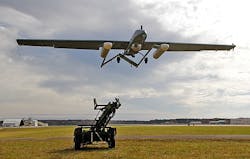Army reaches out to industry for new power and propulsion technologies for next-gen unmanned aircraft
Officials of the Army Contracting Command at Fort Eustis, Va., issued a request for information (W911W6-17-RFI-0001) last week for the Reliable, Advanced Small Power Systems (RASPS) project.
The Army Contracting Command issued the RFI on behalf of the Aviation Development Directorate (ADD) of the Army Aviation and Missile Research, Development, and Engineering Center (AMRDEC) at Redstone Arsenal, Ala.
Army ADD experts are looking for information on reliable, advanced small power systems (RASPS) for the Future Tactical Unmanned Aerial Systems (FTUAS) project.
Related: General Atomics to provide propulsion batteries for U.S. Special Forces mini-submarines
The FTUAS family of aircraft a relatively small unmanned aerial vehicle (UAV) able to fly as high as 15,000 feet that is easily transportable with brigade combat teams. FTUAS also will have a relatively large UAV able to fly as high as 25,000 feet with long range and weapons capability that can support the Army combat aviation brigade.
Army UAV experts consider propulsion technology to be a key enabling technology for these systems. They are focusing on small engine technology unique to military requirements such as heavy fuel operation, increased reliability, reduced fuel consumption, increased horsepower-to-weight ratio, increased durability, reduced noise, and reduced production and maintenance costs.
From industry, Army researchers want information on systems and components of FTUAS propulsion and power systems, their capabilities and risks, advantages and disadvantages, and plans to mitigate risks.
Researchers are focusing on future UAV propulsion and power systems of 40 to 400 horsepower, with immediate plans to develop and test propulsion and power systems in the 40-to-50-horsepower range for the smaller UAVs, and in the 200-to-400-horsepower range for the larger UAVs.
Related: Boeing capitalizes on unmanned submersible propulsion to develop fuel cell energy storage
All offerings must be inherently designed to run on heavy fuel, such as diesel fuel or JP8 jet fuel.
Army researchers are asking for white papers that describe applicable small power systems that are ready for design; the technology state of the art; relevant research projects; expected amount of effort and costs to design relevant power systems; expected operating costs of 30 hours of testing; expected support costs of 500 hours of testing; and how propulsion technologies could be scaled up or down for different sizes of UAVs.
Companies interested should email 20-page white papers no later than 28 Nov. 2016 to the Army's Kenny Hood at [email protected] via the AMRDEC safe access and file exchange Website at https://safe.amrdec.army.mil/SAFE/. Email Hood at [email protected] for questions or concerns.
More information is online at https://www.fbo.gov/notices/1cb3c84a8f3f3cf0533be1805e646079.
Learn more: search the Aerospace & Defense Buyer's Guide for companies, new products, press releases, and videos
